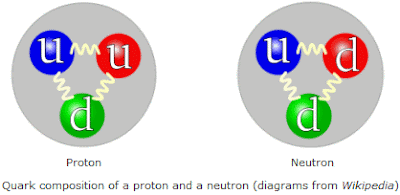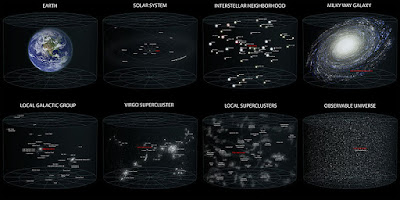According to
Science “Nothing is actually one of the most interesting something in all of
physics”
So, how do
we study Nothing?
Consider an
empty Jar. An empty Jar is always contain something, like molecules of air and
a bath of infrared light from its warm environment. There’s also the ambient
electromagnetic buzz from the surrounding city and a stream of exotic particles
from the surrounding cosmos. But what if we suck out every last molecule of
air, chill the Jar to absolute zero, and shield it from all eternal radiation?
Then the Jar contain only empty space. But it turns out that empty space is far
from nothing.
(empty space simulation)
Before we
begin we should know what is ‘absolute-cold’. Actually it’s impossible to
reduce any substance to absolute zero in temperature. Zero Kelvin means no
motion whatsoever. But the perfect stillness implies that a particle’s position
and momentum are simultaneously perfectly defined and this is impossible
according to the Heisenberg uncertainty principle. According to uncertainty
principle the position and the velocity of an object cannot both be measured
exactly at the same time. Because particles are always uncertain and vibrant in
very small scale. So, the walls of the empty Jar will always radiate a heat
glow.
But
hypothetically what is a perfectly empty space?
The answer will bring us
closer to understanding the nature of Space itself. Our universe contain planets, stars and galaxies and those are the
things we see. But the only reason these big structures exist is because of the
nature of nothingness. We need to understand why we have to go back to the
beginning, the very beginning, the Big Bang. We always thought that in the Big
Bang the observable universe started from a single point or singularity and
then just expended steadily more or less to the point that we are at today. But
that's not actually how it happened. There were four different phases in the
universe's expansion. To start it was expanding steadily but then after just a
tiny fraction of a second the expansion just blew up and the whole universe
increased in size by ten to the power twenty six times (10^26) in very short period
of time and that period is known as Inflation, which we discussed previously.
After that, universe continued expanding but at a decreasing rate. So the
expansion of the universe was actually slowing down. But then about five or six
billion years ago the expansion of universe started speeding up again and this
is caused by Dark energy an energy tied to space. So before that time there was
enough matter, the matter density was high enough that it was pulling
everything back together and slowing down the expansion. But once the universe
reached a critical size then there was enough dark energy to start pushing
things apart and that is the phase that we are still in. The expansion of the
universe is accelerating.
Although this theory doesn't really explain the
formation of particles until we tie in the nature of nothingness. Everything
around us is made of particles of atoms and electrons but our best theories of
physics are actually field theories.
Quantum nature of space is described by
"Quantum field theory". In short, Space itself is comprised of
fundamental quantum fields, one for each elementary particle. Those field
oscillate, vibrate with different energies and those oscillation are the
electrons, quarks, neutrons, photons, gluons etcetera. That comprise the stuff
of our universe. These fields are quantum fields. Now anywhere there's an
excitation in this field, that is some energy in the field and that is where we
will observe particles.
So the completely empty space is where the
values for all of these fields are basically zero. But it's impossible to make
a field perfectly flat and zero. We can't take a quantum field and make it
completely quiet, because of the Heisenberg's uncertainty principal. It says you
can't take a partial and pinpoint it to exactly zero energy. Likewise you can't
take a quantum field and make it exactly flat everywhere.
Now, this is very important because ordinarily
these fluctuations are really tiny and they only effect subatomic processes.
But during that period of Inflation the universe expanded in size so rapidly
that those tiny fluctuations got blown up to the scale of the observable
universe. Now without them we think the matter distribution in the universe
would have been completely homogeneous, completely uniform and that means the
gravitational force on any object in the universe would have been the same in
all direction. Which means nothing would ever have collapsed into the big
structures that we see today. But thanks to these fluctuations there were
slightly denser and less dense regions. The denser regions had stronger
gravitational fields so they pulled in the matter from around them and that
clumped together the matter into huge gas clouds that would go on to be the galaxies
that contain the stars and the planets and all other things we known today.
We can actually see the imprint of these quantum fluctuations in the leftover
radiation from the Big Bang by the cosmic microwave background radiation.
Now here is another special field which is
Higgs field or Higgs boson or God particles. And the mystery become more
interesting when we discuss about the origin of Mass itself and bring virtual
particle in our discussion.
One of the most amazing things about atoms is
they're mainly empty space. So all of the atoms that make up human, trees, air
and all the solid things in our universe are mostly empty space. But now we
know that empty space is not truly empty.
Empty space is actually full of quarks and gluons field fluctuations. And it is
possible to annihilate a quark from empty space, because it's not empty. The
empty vacuum actually costs an enormous amount of energy to create. If we
create it, we'll discover that is unstable and any sort of perturbation would
push that empty vacuum into something where the vacuum is actually full of
quantum field fluctuation. Now understanding how the quantum vacuum
fluctuations work gives us a sense of what the fundamental particles do.
The origin of Mass is empty space. All of the
mass comes from the Higgs mechanism. Which means that all electrons are
traveling through Space-time, they interact with the Higgs field and through
Higgs field they generate there mass. Higgs field slows them down and stops
them from traveling at the speed of light.
We know most of the mass in our universe comes from neutrons and protons and
they are not fundamental particles. They are made of constituent particles
called quarks. And the theory that describes quarks and their interaction with
each other through gluons is called "Quantum Chromodynamic".
According to this theory we can't create an individual quark, because if we try
to pull one out then we have to put so much energy into the situation that
another quark-antiquark pair will be created.
So, the interesting behaviour about a proton or neutron is that there may be
more than three quarks, because additional quark-antiquark pairs can pop in and
out of existence. So, at any given time there could be five or seven or any odd
number of quarks can make up a proton or neutron. This additional quarks clear
out the vacuum. Then the gluon field will suppress in between them. And that is
really what is binding these quarks together.
So, where is the mass of the proton coming
from? Well obviously the constituent quarks do interact with the Higgs field
and that gives them a small amount of Mass. But if we add up the quarks in the
proton it would only account for about 1% of it's total mass.
So, where is the
rest of the mass coming from? The answer is energy (E = mc 2). The mass is
coming from energy fluctuations in the gluon field and the quarks are
interacting with those gluons and that is how the mass is generating. This
theory is extraordinary because what we think of as ordinarily empty space
actually that turns out to be the thing that gives us most of our mass.
We'll discuss more about virtual particle when
we include "Hawking radiation" in our topic.
















